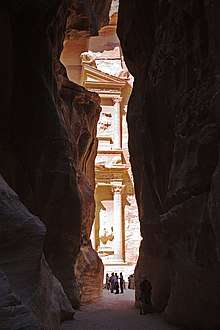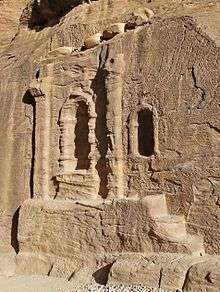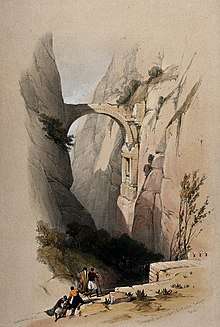Siq
The Siq (Arabic: السيق, transliterated al-Sīq, transcribed as-Sīq,[lower-alpha 1] literally 'the Shaft') is the main entrance to the ancient Nabatean city of Petra in southern Jordan. Also known as Siqit, it is a dim, narrow gorge (in some points no more than 3 metres (10 ft) wide) and winds its way approximately 1.2 kilometres (0.75 mi) and ends at Petra's most elaborate ruin, Al Khazneh (the Treasury). A wide valley outside leading to the Siq is known as the Bab as-Sīq (Gateway to the Siq).


Description

Unlike slot canyons such as Antelope Canyon in the American Southwest, which are directly shaped by water, the Siq is a natural geological fault split apart by tectonic forces; only later was it worn smooth by water. The walls that enclose the Siq stand between 91–182 metres (299–597 ft) in height.[1]
The entrance to the Siq contains a huge dam, reconstructed in 1963 and again in 1991, designed to bar the mouth of the Siq and reroute the waters of Wadi Musa. The dam is a fairly true reconstruction of what the Nabataeans did to control Wadi Musa between the 1st century BC and the beginning of the 1st century AD. The entrance also contains the remnants of a monumental arch, of which only the two abutments and some hewn stones of the arch itself have survived. The arch collapsed in 1896 following an earthquake, but its appearance is known from the lithographs of Matthew Boulby and David Roberts.[1]
The Siq was used as the grand caravan entrance into Petra. Along both walls of the fissure are a number of votive niches containing baetyli, which suggest that the Siq was sacred to the Nabatean people. In 1998, a group of statues were uncovered when digging was conducted to lower the road by more than six feet. Although the upper part is greatly eroded, it is still possible to recognise the figures of two merchants, each leading two camels. The figures are almost twice lifesize.[1]
Along the Siq are some underground chambers, the function of which has not yet been clarified. The possibility that they were tombs has been excluded, and archaeologists find it difficult to believe that they were dwellings. The majority consensus is that they housed the guards that defended the main entrance to Petra.[1]
3D documentation
The Zamani Project spatially documented the Siq and most parts of Petra Archaeological Park in 2011-2014, as part of the UNESCO Siq Stability Project.[2][3][4][5][6][7][8] The non-profit organisation specialises in 3D digital documentation of tangible cultural heritage, and seeks to increase awareness and knowledge of heritage in Africa and beyond. The data generated by Zamani are used for research, education, restoration, conservation and as a record for future generations.[9][10][11]
See also
Notes
- Al is assimilated and pronounced as because s (of Sīq) is a sun letter.
References
- Bourbon, Fabio (1999). Petra: Jordan's Extraordinary Ancient City. New York: Barnes & Noble Books. ISBN 0-7607-2022-3.
- "Site_Petra". zamaniproject.org. Retrieved 2019-09-13.
- "UNESCO launches second phase of project to mitigate disaster risk in Siq - JORDAN TIMES". UNESCO. 2015-10-20. Retrieved 2019-09-13.
- "(PDF) Rock Slope Potential Failures in the Siq of Petra (Jordan). In Sassa K., Canuti P., Yin Y. (eds) Landslide science for a safer geoenvironment. Targeted Landslides. BERLIN HEIDELBERG:Springer-Verlag". ResearchGate. ISBN 978-3-319-04995-3. Retrieved 2019-09-13.
- Mikoš, Matjaž; Casagli, Nicola; Yin, Yueping; Sassa, Kyoji (2017-05-20). Advancing Culture of Living with Landslides: Volume 4 Diversity of Landslide Forms. Springer. ISBN 9783319534855.
- "SA team to map Petra". BusinessLIVE. Retrieved 2019-09-13.
- "Wadi Farasa, Petra - Taking the Lesser Travelled Path -". lidarnews.com. 2016-08-21. Retrieved 2019-09-13.
- "Laser scanning of Petra" (PDF).
- Rüther, Heinz. "An African heritage database, the virtual preservation of Africa's past" (PDF). www.isprs.org.
- Rajan, Rahim S.; Rüther, Heinz (2007-05-30). "Building a Digital Library of Scholarly Resources from the Developing World: An Introduction to Aluka". African Arts. 40 (2): 1–7. doi:10.1162/afar.2007.40.2.1. ISSN 0001-9933.
- Rüther, Heinz; Rajan, Rahim S. (December 2007). "Documenting African Sites: The Aluka Project". Journal of the Society of Architectural Historians. University of California Press. 66 (4): 437–443. doi:10.1525/jsah.2007.66.4.437. JSTOR 10.1525/jsah.2007.66.4.437.
Further reading
- Parr, Peter (2008). "Dating the Hydraulic Installations in the Siq at Petra". Palestine Exploration Quarterly. 140 (2): 81–86. doi:10.1179/003103208X312836.
External links
